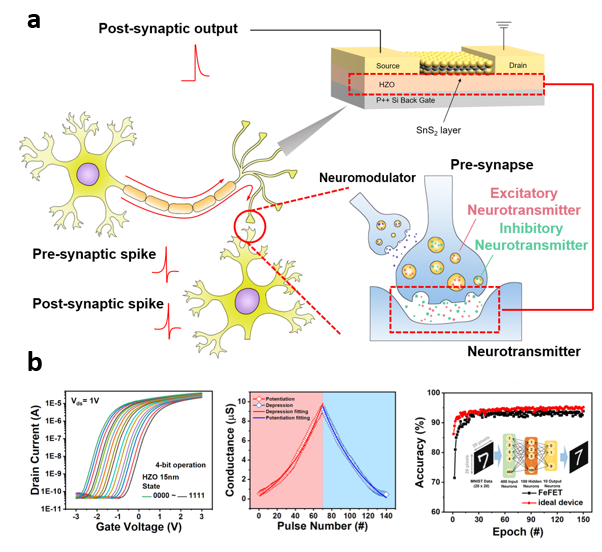Research News
DGIST Develops Next-Generation Artificial Intelligence (AI) Semiconductor Devices Resembling the Human Brain
- DGIST Prof. Hyuk-Jun Kwon's team has developed neuromorphic devices using ferroelectrics and two-dimensional channels.
- Similar to the human brain, they perform both computational and memory functions––but 10,000 times faster than synapses with minimal energy consumption.
- Their application to next-generation AI semiconductor technology is anticipated.

DGIST (President Kunwoo Lee) announced on Thursday February 29th that a team led by Prof. Kwon Hyuk-jun of the Department of Electrical Engineering and Computer Science has developed a next-generation AI semiconductor technology that mimics the human brain's efficiency in AI and neuromorphic systems.
The advancement of AI has stimulated rapidly growing demand for energy efficient semiconductor technology with a fast operational speed. However, traditional computing devices with their von Neumann architecture and separate computing and memory units have speed and energy efficiency shortcomings associated with data processing bottlenecks. Consequently, research on neuromorphic devices that mimic biological neurons’ simultaneous computing and memory functions is gaining attention.
Against this backdrop, Prof. Hyuk-Jun Kwon's team developed synaptic field effect transistors using hafnium oxide, which has strong electrical properties, and thin layers of tin disulfide. This resulted in a three-terminal neuromorphic device capable of storing multiple levels of data in a manner similar to neurons.
The research successfully replicated biological characteristics such as short- and long-term properties, yielding a highly efficient device that responds 10,000 times faster than human synapses and consumes very little energy.
Prof. Hyuk-Jun Kwon of the Department of Electrical Engineering and Computer Science said, "This research marks an important step toward next-generation computing architecture, which requires low power consumption and high-speed computation. We have developed high-performance neuromorphic hardware using two-dimensional channels and ferroelectric hafnium oxide, and the innovation is expected to have various AI and machine learning related applications in the future."
A paper, with integrated master's and doctoral student Chong-Myeong Song as the first author and Prof. Hyuk-Jun Kwon as the corresponding author, was published online on February 20, 2024 in the prestigious journal Advanced Science, which has an impact factor of 17.521. The research was supported by the Ministry of Science and ICT's Basic Research Project, the Next-Generation Intelligent Semiconductor Technology Development Project, and the Nano Material Technology Development Project.
[Conceptual Diagram of Analog Neuromorphic Device]

--------------
More Information : Chong-Myeong Song, Dongha Kim, Shinbuhm Lee, and Hyuk-Jun Kwon*, Ferroelectric 2D SnS2 Analog Synaptic FET, Advanced Science, on-line published on 20 February, 2024. https://doi.org/10.1002/advs.202308588
- Next Prof. Sang Hyun Park's research team has collaborated with a Stanford University research team to enhance defect detection performance in smart factories! 2024-03-23
- Pre DGIST Achieves Simultaneous Performance Improvement and Energy Savings with Innovative Algorithm for 6G Vision Services! 2024-03-23
